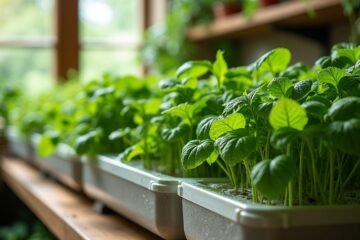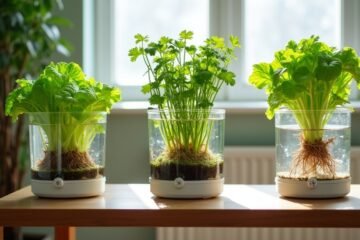Want to make your urban garden shine year-round? Start by choosing seasonal superstars like daffodils in spring and sunflowers in summer! Then, grab the right containers—think durable ceramic for your herbs and charming terracotta for your tomatoes. Next, team up plants like basil and tomatoes to enhance flavors while keeping pesky pests at bay! Don’t forget to monitor that precious soil quality too. Intrigued? Let’s uncover even more fantastic tips to keep your green sanctuary flourishing!
Choose the Right Plants for Each Season
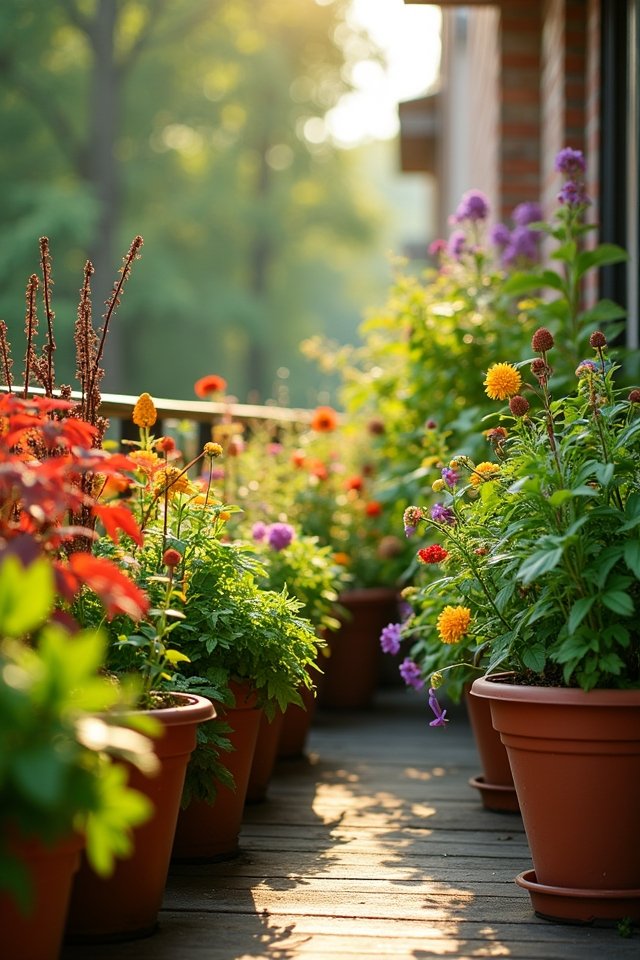
When it comes to choosing the right plants for each season, you’ll want to think like a gardener with a flair for the dramatic! Imagine vibrant seasonal blooms painting your urban garden, each petal a brushstroke of innovation. For spring, consider cheery daffodils, their golden heads nodding in the breeze. In summer, sunflowers stand tall, basking in the sun’s warm hug. Fall calls for rich-colored chrysanthemums, showcasing nature’s cozy palette. And let’s not forget winter! How about snowdrops, bravely peeking through the frost? Each plant should reflect climate adaptation, thriving beautifully in your unique environment. So, why settle for ordinary? Immerse yourself in seasonal magic and transform your garden into a stunning tapestry of life, color, and joy! Isn’t that what every garden deserves?
Optimize Container Size and Material
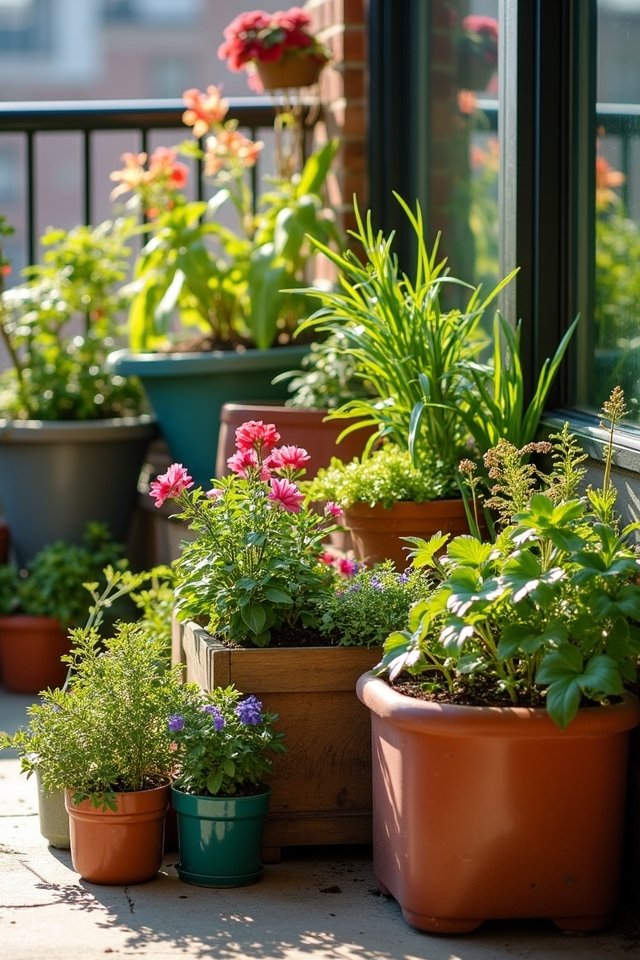
Choosing the right container can make all the difference in your urban garden! Think of your plants as artists, needing the perfect canvas. The container materials you choose—like durable ceramic or breathable fabric—can influence their growth. Lightweight plastic is great for hanging gardens, while terracotta adds a rustic charm!
Now, let’s talk ideal sizes. A small pot might restrict roots, turning your plants into cramped sardines! Instead, aim for larger containers that allow for healthy growth and drainage. For herbs, 12-inch pots work wonders, while tomatoes thrive in 18-inch beauties.
Implement Companion Planting Techniques

While you might think of planting as a solo act, companion planting turns your garden into a lively ensemble! Imagine tomatoes happily sharing space with basil—those two are like best friends, enhancing each other’s flavors! Not only that, but certain plant pairings can also boost your pest management strategy. For instance, marigolds can deter pesky aphids while attracting beneficial insects. Isn’t that genius? You’ll create a vibrant ecosystem that’s both beautiful and functional. Try mixing carrots with onions; the onion’s scent confuses pests, keeping your carrots safe and sound. Adopt this innovative approach, and watch your urban garden thrive with harmony and freshness. So, grab those seeds and get planting—your garden’s new friends are waiting!
Monitor Soil Quality and Nutrients
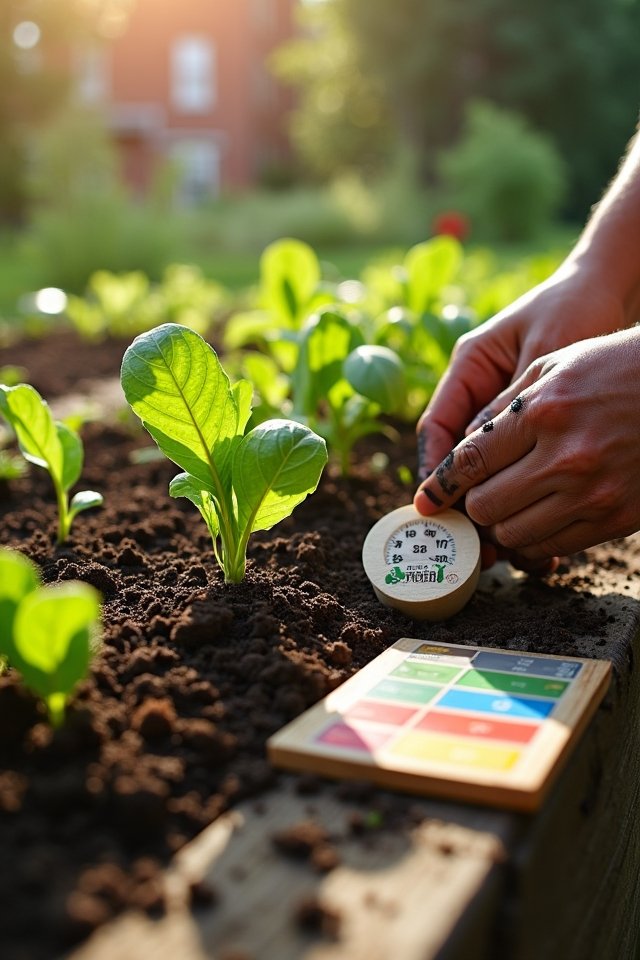
To keep your urban garden thriving, you’ve got to pay attention to soil quality and nutrients—after all, it’s the foundation of your green paradise! Think of your soil as a gourmet meal; it needs the right ingredients. Start with soil testing to check pH levels and nutrient content. You wouldn’t bake a cake without measuring flour, right? Once you know what your soil craves, you can add nutrient amendments like compost or organic fertilizers. Picture your plants dancing with joy as they soak up those fresh nutrients! Regularly monitor these elements, and you’ll guarantee your garden flourishes like a vibrant city park. So, roll up your sleeves, dig in, and let your garden thrive! 🌱
Utilize Vertical Gardening Solutions

If you’ve ever felt like your urban garden was running out of space, it’s time to think vertically! Vertical gardening solutions are the perfect way to maximize every inch of your space. Consider using vertical trellising options—think of them as the skyscrapers of your garden! They’re great for climbing plants like peas and tomatoes, giving your garden a vibrant, layered look. You can also hang planters from walls or railings; they’re like little pockets of greenery that brighten up any area! Imagine cascading herbs or colorful flowers swaying in the breeze. Plus, they’ll save space for your other plants. So, why not elevate your gardening game? Go ahead, reach for the sky and watch your urban oasis thrive!
Frequently Asked Questions
How Can I Attract Pollinators to My Urban Garden?
Want to attract pollinators to your urban garden? Start with native plants! They’re like a five-star restaurant for bees and butterflies. Mix in flower diversity, too—think bright sunflowers, delicate lavender, and cheerful coneflowers. This colorful buffet will keep them buzzing happily! Don’t forget to create cozy spots with rocks or logs for shelter. Your garden can be a vibrant, pollinator-friendly paradise! Who wouldn’t want to be surrounded by all that buzzing beauty?
What Are the Best Herbs for Year-Round Growth in Urban Settings?
You might think indoor gardening limits your herb options, but think again! For year-round growth, consider herb varieties like basil, mint, and rosemary. They thrive in pots, bringing vibrant flavors and aromas right to your kitchen. Imagine snipping fresh basil for a pasta dish or mint for a revitalizing tea! Just give them plenty of light and water, and you’ll have a mini herb paradise, even in the heart of the city! Exciting, right?
How Do I Prevent Pests in a Small Urban Garden?
To keep pests at bay in your small urban garden, use organic repellents like neem oil and garlic spray! Companion planting is a game-changer, too—pairing marigolds with your veggies can confuse those pesky critters. You’ll feel like a garden superhero! Remember, a healthy balance attracts helpful insects that feast on the villains. So, let your garden bloom beautifully while you outsmart the pests with nature’s clever tricks! Isn’t that exciting?
What Is the Ideal Watering Schedule for Seasonal Plants?
To keep your seasonal plants thriving, it’s all about that ideal watering schedule! You’ll want to water deeply, but less frequently, around once or twice a week. This helps with moisture retention, letting those roots drink up all the goodness. Think of it like giving your plants a revitalizing spa day! Just remember, overwatering can drown them, so check the soil first. Healthy plants equal happy gardening! Isn’t that a delightful thought?
Can I Grow Vegetables Indoors During Winter Months?
Absolutely, you can grow winter vegetables indoors! Think of your home as a cozy greenhouse. With some bright pots, soil, and a sunny window, you can cultivate delicious greens like spinach and kale. Just imagine plucking fresh leaves for your winter salads! Keep that indoor gardening spirit alive, and don’t forget to check moisture levels. Who knew winter could be so tasty? So, roll up your sleeves and let those veggies flourish!
